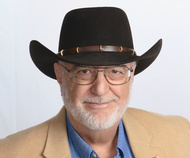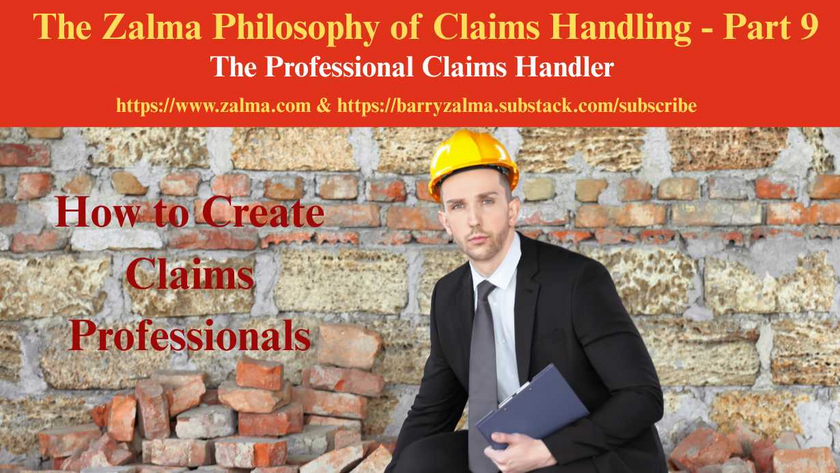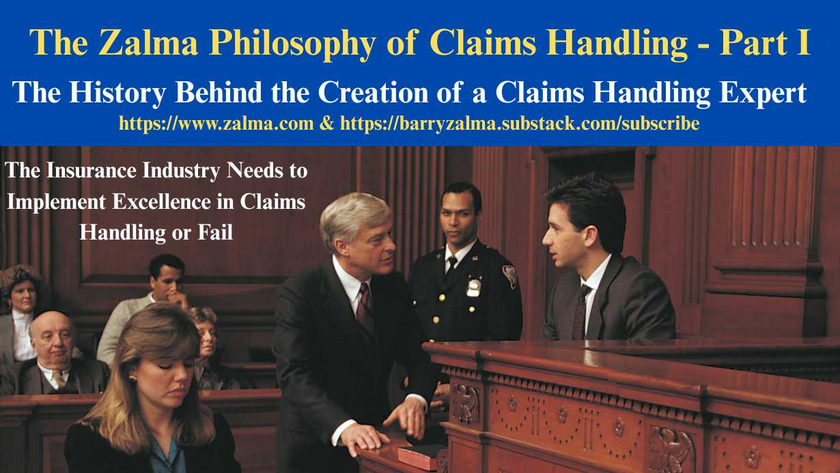
A True Crime Story of Insurance Fraud
Post 4997T
Read the full article at https://lnkd.in/gpSDFFd6, see the full video at https://lnkd.in/gsbbrJt6 and at https://lnkd.in/g9vz4XDf and at https://zalma.com/blog plus more than 4950 posts. This is just a taste of the article.
This is a fictionalized true crime story of insurance fraud explaining why insurance fraud is a “Heads I Win, Tails You Lose” situation for insurers. The story that follows is designed to help everyone understand how insurance fraud in America is costing everyone who buys insurance thousands of dollars every year and why insurance fraud is safer and more profitable for the perpetrators than any other crime.
The jeweler had learned to cut diamonds in Antwerp. For ten years he worked in a small office grinding facets onto stones of half a carat or less. The boredom of the job infuriated him. He had no future.
He decided to immigrate to the United States where he could use his skills. He turned his savings into small diamonds which he purchased below wholesale from the marketplace in Antwerp. He started business immediately upon arrival, trading diamonds in the Los Angeles wholesale market. His knowledge as a cutter allowed him to make profitable trades and sales.
He came to the United States on a tourist visa. He knew that the only way he could become a legal permanent resident was to have a business in place. The income he derived from his sales was sufficient to allow him to live in Southern California, but not set up a business. He needed a large influx of cash.
After only a month working the wholesale jewelry market, the jeweler learned about insurance. It seemed to him that when they weren’t talking about gems all jewelers spoke about insurance. It was expensive. The insurers required them to install sophisticated alarm systems. The insurers required them to install safes that far exceeded any need of reasonable security.
Other, less honest, jewelers used their insurance company to make a bad year into a good year. Cheating an insurance company, they explained, is simple. The insurance company would accept whatever books and records a jeweler gave them. Thus, not marking sold on an item in an inventory book, he could sell a gem twice. First, it is sold to the customer. Second, when the jeweler reports a loss, robbery or burglary it is sold to the insurance company since it is still noted in his inventory as being present to steal.
The jeweler saw insurance as a way of setting up a permanent business and becoming a legal resident of the United States.
He got from his jeweler acquaintances the name of an insurance broker who asked few questions. He contacted that broker. He told the broker that he was a diamond salesman who operated his business from his home. The broker presented an application to Underwriters at Lloyd’s, London since no American markets would accept such a risk. The Underwriters at Lloyd’s refused to insure the jeweler because he had insufficient security at his apartment.
The jeweler was undaunted. He went to another insurance broker. This time he described his business premises as the location of one of his acquaintances. He put on the new application the address of the acquaintance. He also included the type of safe at the acquaintance’s premises, the type of alarm system and all other security devices of the premises. The jeweler described his inventory as $100,000 in loose diamonds.
The jeweler knew, but did not disclose to the insurer at the time he bought the policy, that his inventory consisted of many very small diamonds whose values totaled no more than $10,000. He created an inventory book describing $100,000 in diamonds by merely placing one or two 0’s after the total carat weight of the diamonds he had in inventory.
The broker submitted the proposal to three insurers, including the RLI Insurance, Chubb Insurance and Protection & Indemnity Company of Puerto Rico who was the only insurer willing to insure him. He was pleased to accept that policy.
One month later, he reported to Jewelers Protection & Indemnity Company that he had been the victim of an armed robbery. He had an appointment with a retail jeweler in Cerritos, California to show his loose diamonds. The jeweler arrived in Cerritos early and stopped at the local Denny’s to have lunch. He had all of his inventory in a small leather pouch in his inside coat pocket. It was a warm spring afternoon. When he pulled into the parking lot of Denny’s Restaurant, his window was rolled down. As he turned off his engine he looked to his left and saw a black man holding a chrome-plated pistol. The pistol pointed at the jeweler’s mouth. The black man demanded his wallet. The insured complied. The man instructed the insured to put his hand on the dash and his face on the steering wheel. Frightened, he did as they told him.
The black man than reached into the window and struck him across the forehead with the pistol. The jeweler was unconscious for a short time and awoke with his head slumped against the steering wheel. The thief must have reached into his coat pocket because the pouch containing the diamonds was gone.
The loss was highly suspicious. The insurer’s adjuster noted multiple red flags or indicators of insurance fraud:
1 It came soon after the policy was issued.
2 It happened in a way that appeared to be physically impossible.
3 The bruise was on the right side of the jeweler’s head.
4 It seemed that the armed robber would have had to reach in across the insured’s face and then double back with his pistol to strike him as described.
The insurer retained counsel to examine the jeweler under oath. The jeweler, on the recommendation of his insurance broker, retained counsel to represent the insured’s interest. Counsel for the insured became quite bored with the proceedings. The insurer’s attorney, being familiar with the intricacies of a Jewelers’ Block policy and the warranties made by an insured when purchasing a Jewelers’ Block policy, inquired in copious detail about each statement made in the proposal for Jewelers’ Block insurance. The insured responded to each question thoroughly. The Insured delayed his responses, however, because of the need for a French language interpreter that allowed him to hear each question twice, once in English and then again in French.
The insured’s counsel, well over sixty years of age, could take it no longer. He fell asleep on the sofa in the office of the attorney for the insurer. While the insured’s counsel slept, the insured admitted that he operated his business from his home. He also admitted that he did not have an alarm system in the home that he did not have a safe in the home and that he did not do business at the location specified on the proposal. Rather, it was the business location of a friend who would occasionally let him store his inventory in the friend’s safe.
Counsel asked, when faced with these truthful responses, why the insured had listed a business address for his jewelry business when, in fact, he had none. The jeweler explained that when he had honestly reported his business arrangements, he could not get insurance.
Counsel for the insurance company completed the examination under oath shortly thereafter. He awakened counsel for the insured and wished them a good day.
Counsel for Jewelers Protection & Indemnity Company then advised his client to immediately rescind the policy of insurance for willful material breaches of warranty and misrepresentation of material fact.
The testimony by the jeweler clearly established that the jeweler knew that he was not eligible for insurance with anyone, including even Lloyd’s Underwriters, because of a lack of security. The jeweler intentionally and willfully misrepresented the state of his business and security to get the insurance. There was never an an honest and honorable agreement between the insured and the insurer about the risk the insurer was asked to take. The policy was obtained, without question, by fraud.
The insurer agreed and counsel advised the insured’s attorney of the rescission. Counsel referred the attorney for the insured to the line and page number of the transcript of the examination under oath where the jeweler admitted to misrepresentation on the proposal form.
The jeweler met with his lawyer to discuss his future actions. He could not understand why he did not recover $100,000 from his insurance company like his friends had suggested.
The insured’s lawyer, although drowsy, was familiar with the law. He had no intention of becoming a party to a fraud. He explained to the jeweler what he had done, even if done without malice, was sufficient to allow an insurance company to rescind the policy for fraud.
The lawyer explained to the jeweler that his actions were not only wrong civilly, but, in California, an attempt to defraud an insurer was also a criminal offense. If the jeweler was not careful he might be arrested and spend five years in the state penitentiary. He could also be shipped out of the country as an undesirable alien. The lawyer suggested that the jeweler leave well enough alone. The insurance company seemed willing to close out their books without payment and not pursue criminal prosecution. If he upset them, he might find himself facing criminal charges. Finally, because the lawyer knew of the fraud, he made it clear to the insured that he refused to sue for the jeweler.
The jeweler’s attempt at fraud could have been successful. His mistake was not knowing enough about insurance law. His mistake was giving the lawyer for the insurance company facts that enabled the insurance company to rescind his policy. To be competent and effective as a perpetrator of insurance fraud it is necessary to know when to lie and when to tell the truth.
The jeweler did not know. He told the truth when he should have lied. He lied when he should have told the truth.
(c) 2025 Barry Zalma & ClaimSchool, Inc.
Please tell your friends and colleagues about this blog and the videos and let them subscribe to the blog and the videos.
Subscribe to my substack at https://lnkd.in/gmmzUVBy
Go to X @bzalma;
Go to the Insurance Claims Library – https://lnkd.in/gwEYk
Insurer’s Exclusion for Claims of Assault & Battery is Effective
Post 5250
Read the full article at https://lnkd.in/gBzt2vw9, see the video at https://lnkd.in/gEBBE-e6 and at https://lnkd.in/gk7EcVn9, and at https://zalma.com/blog plus more than 5250 posts.
Bar Fight With Security is an Excluded Assault & Battery
In The Cincinnati Specialty Underwriters Insurance Company v. Mainline Private Security, LLC, et al., Civil Action No. 24-3871, United States District Court, E.D. Pennsylvania (December 16, 2025) two violent attacks occurred in Philadelphia involving young men, Eric Pope (who died) and Rishabh Abhyankar (who suffered catastrophic injuries). Both incidents involved security guards provided by Mainline Private Security, LLC (“Mainline”) at local bars. The estates of the victims sued the attackers, the bars, and Mainline for negligence and assault/battery. The insurer exhausted a special limit and then denied defense or indemnity to Mainline Private Security.
INSURANCE COVERAGE
Mainline had purchased a commercial ...
Marine Insurer May Dispose of Vessel to Avoid Waste
Post 5249
Read the full article at https://lnkd.in/gfn_UHdp, see the video at https://lnkd.in/gDWVccnr and at https://lnkd.in/gv9nsBqk, and https://zalma.com/blog plus more than 5200 posts.
In Western World Insurance Company v. The Estate Of Shawn Arsenault, No. 25-cv-13413-PGL, United States District Court, D. Massachusetts (December 17, 2025) the USDC was asked to resolve a marine insurance dispute after the sinking of the F/V Seahorse, a commercial fishing vessel, off Cape Cod on June 8, 2025. The vessel’s owner and operator, Shawn Arsenault, died in the incident.
Western World Insurance Company issued a hull insurance policy for the vessel. With no personal representative yet appointed for the estate, the insurer cannot determine the proper payee for the insurance proceeds.
The insurer paid for the vessel’s recovery and removal, and the vessel is now with a salvage company, incurring substantial storage fees. The insurer determined the loss is covered under the ...
Marine Insurer May Dispose of Vessel to Avoid Waste
Post 5249
Read the full article at https://lnkd.in/gfn_UHdp, see the video at https://lnkd.in/gDWVccnr and at https://lnkd.in/gv9nsBqk, and https://zalma.com/blog plus more than 5200 posts.
In Western World Insurance Company v. The Estate Of Shawn Arsenault, No. 25-cv-13413-PGL, United States District Court, D. Massachusetts (December 17, 2025) the USDC was asked to resolve a marine insurance dispute after the sinking of the F/V Seahorse, a commercial fishing vessel, off Cape Cod on June 8, 2025. The vessel’s owner and operator, Shawn Arsenault, died in the incident.
Western World Insurance Company issued a hull insurance policy for the vessel. With no personal representative yet appointed for the estate, the insurer cannot determine the proper payee for the insurance proceeds.
The insurer paid for the vessel’s recovery and removal, and the vessel is now with a salvage company, incurring substantial storage fees. The insurer determined the loss is covered under the ...
Zalma’s Insurance Fraud Letter
Read the full article at https://lnkd.in/dG829BF6; see the video at https://lnkd.in/dyCggZMZ and at https://lnkd.in/d6a9QdDd.
ZIFL Volume 29, Issue 24
Subscribe to the e-mail Version of ZIFL, it’s Free! https://visitor.r20.constantcontact.com/manage/optin?v=001Gb86hroKqEYVdo-PWnMUkcitKvwMc3HNWiyrn6jw8ERzpnmgU_oNjTrm1U1YGZ7_ay4AZ7_mCLQBKsXokYWFyD_Xo_zMFYUMovVTCgTAs7liC1eR4LsDBrk2zBNDMBPp7Bq0VeAA-SNvk6xgrgl8dNR0BjCMTm_gE7bAycDEHwRXFAoyVjSABkXPPaG2Jb3SEvkeZXRXPDs%3D
Zalma’s Insurance Fraud Letter (ZIFL) continues its 29th year of publication dedicated to those involved in reducing the effect of insurance fraud. ZIFL is published 24 times a year by ClaimSchool and is written by Barry Zalma. It is provided FREE to anyone who visits the site at http://zalma.com/zalmas-insurance-fraud-letter-2/
Zalma’s Insurance Fraud Letter
Merry Christmas & Happy Hannukah
Read the following Articles from the December 15, 2025 issue:
Read the full 19 page issue of ZIFL at ...
The Professional Claims Handler
Post 5219
Posted on October 31, 2025 by Barry Zalma
An Insurance claims professionals should be a person who:
Can read and understand the insurance policies issued by the insurer.
Understands the promises made by the policy.
Understand their obligation, as an insurer’s claims staff, to fulfill the promises made.
Are competent investigators.
Have empathy and recognize the difference between empathy and sympathy.
Understand medicine relating to traumatic injuries and are sufficiently versed in tort law to deal with lawyers as equals.
Understand how to repair damage to real and personal property and the value of the repairs or the property.
Understand how to negotiate a fair and reasonable settlement with the insured that is fair and reasonable to both the insured and the insurer.
How to Create Claims Professionals
To avoid fraudulent claims, claims of breach of contract, bad faith, punitive damages, unresolved losses, and to make a profit, insurers ...

The History Behind the Creation of a Claims Handling Expert
The Insurance Industry Needs to Implement Excellence in Claims Handling or Fail
Post 5210
This is a change from my normal blog postings. It is my attempt. in more than one post, to explain the need for professional claims representatives who comply with the basic custom and practice of the insurance industry. This statement of my philosophy on claims handling starts with my history as a claims adjuster, insurance defense and coverage lawyer and insurance claims handling expert.
My Training to be an Insurance Claims Adjuster
When I was discharged from the US Army in 1967 I was hired as an insurance adjuster trainee by a professional and well respected insurance company. The insurer took a chance on me because I had been an Army Intelligence Investigator for my three years in the military and could use that training and experience to be a basis to become a professional insurance adjuster.
I was initially sat at a desk reading a text-book on insurance ...













